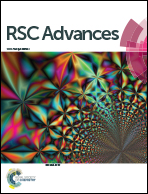Polyaniline nanofibers–graphene oxide nanoplatelets composite thin film electrodes for electrochemical capacitors†
Abstract
Composite thin films of polyaniline (PANI) nanofibers and graphene oxide (GO) nanoplatelets are synthesized through a simple electrodeposition process for electrochemical capacitors. The morphology and structure of the materials are investigated by field emission scanning electron microscopy, transmission electron microscopy, current sensing atomic force microscopy, X-ray photoelectron spectroscopy, Fourier transforms infrared spectroscopy, X-ray diffraction, and ultraviolet-visible spectroscopy. In the process of electrodeposition, the electrostatic interactions between the oxygen-functionalized graphene and aniline monomers at an electrolyte interface assisted the co-deposition of PANI nanofibers and GO nanoplatelets. These thin films have an excellent effect on the electrochemical properties with an electrochemical capacitance of 662 F g−1 at a low current density of 0.025 mA cm−2 with simultaneous high energy density (64.5 W h kg−1) and high power density (1159 W kg−1). The excellent electrochemical performance of the films is attributed to the unique structure of the material, showing synergy between PANI nanofibers and GO nanoplatelets.


 Please wait while we load your content...
Please wait while we load your content...